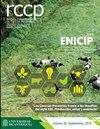在繁殖前补充咖啡浆可以改善氧化状态,而不影响母羊的生育能力
IF 0.5
4区 农林科学
Q4 AGRICULTURE, DAIRY & ANIMAL SCIENCE
引用次数: 3
摘要
背景:咖啡果肉含有高含量的抗氧化剂,能够改变小反刍动物的氧化状态。然而,长期大量摄入会降低生育能力。目的:探讨发情同步过程中两种咖啡浆内含物水平对初产妇生殖变量和氧化状态的影响。方法:采用完全随机设计,将60只萨福克x多塞特母羊分为三个处理组;T0:(n=20)1.5 kg均衡饮食,Tl:(n=20)1.5公斤均衡饮食和5%咖啡浆,T2:(n=2 0)1.5公斤平衡饮食和10%咖啡浆。在发情期同步前和繁殖季节开始前进行16天的补充。植入孕激素(CIDR®)所有天,并在停药前两天施用一剂PGF2a。CIDR停药12小时后开始检测雌激素。在补充期间采集血样,以测量氧化状态、抗氧化能力、葡萄糖和胰岛素,并在繁殖后9天内测定孕酮浓度。在繁殖后30天和60天进行妊娠诊断。进行了混合效应重复测量的分析和频率分析。结果:在繁殖前短时间加入咖啡浆不会影响生殖参数,也不会影响孕酮、葡萄糖或胰岛素浓度(p>0.05);然而,抗氧化能力增加,而脂质氧化则呈现相反的趋势(p<0.05)。结论:在繁殖前16天,在母羊羔羊的日粮中加入高达10%的咖啡浆可以改善氧化状态,而不会对妊娠、发情或多产造成不利影响。本文章由计算机程序翻译,如有差异,请以英文原文为准。
Coffee pulp supplementation prior to breeding improves oxidative status without affecting fertility of primiparous ewes
Background: Coffee pulp has a high content of antioxidants capable of modifying the oxidative status in small ruminants. However, high amounts for a prolonged time can reduce fertility. Objective: To determine the effect of two inclusion levels of coffee pulp during estrous synchronization on reproductive variables and oxidative status of primiparous ewes. Methods: Sixty Suffolk x Dorset primiparous ewes were distributed into three treatments in a completely randomized design; T0: (n=20) 1.5 kg balanced diet, Tl: (n=20) 1.5 kg balanced diet and 5% coffee pulp, T2: (n=20) 1.5 kg balanced diet and 10% coffee pulp. Supplementation was given for 16 days before estrus synchronization and until the beginning of the breeding season. A progestogen (CIDR®) was inserted for ll days and a dose of PGF2a was applied two days prior to its withdrawal. Estrus detection started 12 hours after CIDR withdrawal. Blood samples were obtained during the supplementation period to measure oxidative status, antioxidant capacity, glucose and insulin, and up to 9 days after breeding to determine progesterone concentration. Pregnancy diagnosis was performed at 30 and 60 days post-breeding. An analysis of repeated measures of mixed effects and frequency analysis were carried out. Results: Inclusion of coffee pulp for a short period prior to breeding did not affect reproductive parameters, nor progesterone, glucose or insulin concentrations (p>0.05); however, antioxidant capacity increased, while lipid oxidation showed an opposite trend (p<0.05). Conclusion: Inclusion of up to 10% coffee pulp in the diet of ewe lambs for 16 days prior to breeding improves oxidative status without causing adverse effects on pregnancy, estrus or prolificacy.
求助全文
通过发布文献求助,成功后即可免费获取论文全文。
去求助
来源期刊

Revista Colombiana De Ciencias Pecuarias
AGRICULTURE, DAIRY & ANIMAL SCIENCE-
CiteScore
0.80
自引率
0.00%
发文量
18
审稿时长
6-12 weeks
期刊介绍:
The editors of Revista Colombiana de Ciencias Pecuarias (RCCP) welcome the submission of original manuscripts on experimental and clinical studies associated with the broad areas of animal sciences and veterinary medicine as they interface with biochemistry, molecular biology, physiology, pharmacology, toxicology, pathology, microbiology, parasitology, immunology and epidemiology. The scope of the journal includes studies of basic and applied research in animal management and production, feeding and nutrition, reproduction, breeding, genetics, animal welfare and behavior; as well as animal production focussed from biotechnology, soil science, agrostology, silvopastoral systems, livestock economics and the environment.
The criteria for acceptance of papers submitted for publication are originality, quality and clarity of the content. Each contribution must be based on original, unpublished research that has not been simultaneously submitted to other journals. All papers will be peer reviewed. All authors bear responsibility for ensuring the integrity and quality of their reported research. It is the author''s responsibility to secure permission to use figures or tables that have been published elsewhere.
Contributions may be classified as original research, review, rapid communication, clinical case studies or methodological articles, as well as news/commentaries or letters to the editor. Most review articles are invited by the editor. Authors interested in submitting a review article should contact the corresponding editor. Rapid publication of original manuscripts is a goal of the journal. Manuscripts must be written in English. Each manuscript is considered for publication with the understanding that it has not been simultaneously submitted to any other journal. Upon acceptance for publication, papers are subject to editorial review and revision.
 求助内容:
求助内容: 应助结果提醒方式:
应助结果提醒方式:


